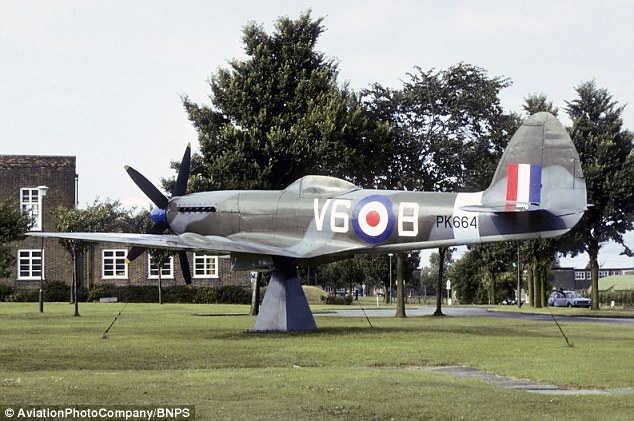- Museum used the grounded Spitfire to pay a firm to recover an RAF Kittyhawk P40 discovered preserved in the Sahara desert
- But even though it was recovered the plane from the Africa campaign has been stuck in a Egyptian warehouse since the Arab Spring in 2012
One of the few remaining airworthy Spitfires is feared to have been lost to the nation after an ‘ill-conceived’ deal by the RAF Museum.
The museum, in Hendon, North London, used it to ‘pay’ a firm to recover another historic aircraft from the Sahara.
But three years on the museum, of which Prince Philip is a patron, says it may never see the RAF Kittyhawk P40, which was discovered almost perfectly preserved in the middle of the Western Desert in Egypt.

Lost to the nation: The Spitfire PK664 that the RAF Museum in Hendon, North London, used to pay a salvage company to recover another historic British warplane from the Sahara desert in Egypt
Although the aircraft was recovered nearly intact in 2012 and taken in a shipping container to El Alamein, it is stuck there as a result of the turmoil that has gripped Egypt since the Arab Spring.
There is a possibility that the authorities in Cairo will deem it to be Egyptian property.
The museum’s annual report admits: ‘Given the uncertain political situation in Egypt there is a possibility that Kittyhawk may never be returned.’ However, Iain Thirsk, head of collections at the museum, said: ‘We are still hoping to get it back to the UK.’
Meanwhile Kennet Aviation, the Essex-based firm that salvaged the Kittyhawk, was handed Spitfire PK664 as payment.
Ray Burgess, treasurer of the Spitfire Society, said: ‘There are 18 flying Spitfires in the UK. They are very important and have come to symbolise all those people who died in them. So we are very sorry to hear that one has gone from being owned for the nation to private hands.’
He also criticised the British authorities over the recovery of the Kittyhawk, which crashed in 1942, as no attempt was made to recover the remains of the pilot, Flight Sergeant Dennis Copping. There was evidence that he survived the impact but perished in the inhospitable desert.
In the latest RAF Museum annual report, it states: ‘In 2012 the museum undertook a joint project with Kennet Aviation to recover RAF Kittyhawk ET574 from the Egyptian desert in exchange for one of the Spitfires from the museum’s collection.
‘The aircraft has been successfully retrieved and for the time being remains in secure storage in Egypt.
‘Given the uncertain political situation in Egypt however there is a possibility that Kittyhawk may never be returned to the United Kingdom.’


The report values the grounded Spitfire at £200,000. An airworthy Spitfire with some historic significance is generally valued at between £1m to £3m.
Pat Chriswick, a military aviation historian, said: ‘The RAF Museum have done a deal where they have got no delivery whatsoever. They have been incredibly naive.
‘Surely there should have been some arrangement whereby it was dependent on the success of the recovery project.
‘The Kittyhawk was recovered from the desert and taken to El Alamein. It is not a big surprise that the aircraft hasn’t left the country.
‘The exchange was ill-conceived and badly managed. The RAF Museum has nothing to show for it and the nation has lost a perfectly good and valuable Spitfire.’
William Pryor-Bennett, the nephew of Fl Sgt Copping, has previously said: ‘The priority should be on finding my uncle rather than the plane.
‘The plane is of little interest to me, if they recover it and bring it to the UK then great, but there should be more focus of searching for him.
‘It’s terrible that the RAF Museum have been short-changed like they have.’
Mr Thirsk described the matter as ‘very frustrating’ and confirmed the deal to give Kennet Aviation the Spitfire was in exchange for the recovery of the Kittyhawk.
He said: ‘The situation in Egypt is very unstable. There is no formal undertaking or promise (to get the Kittyhawk) but we are working on that.
‘The matter is not high on the agenda of the Egyptians.
‘We are continuing to work with them. It is very frustrating. To us it (the Kittyhawk) is very important but the Egyptian government have far more important things to think about.’

Simon Brand, the defence attache at the British Embassy in Cairo, said: ‘The plane is still in Egypt.
‘It doesn’t belong to the British government, it was found on the soil of a sovereign territory and they have a right to claim ownership of it.’
It is not clear what Kennet Aviation’s intentions are with the Spitfire which is believed to be in storage in a hangar at an airfield in Essex.
Spitfire PK664 first flew in November 1945 – after the end of World War Two – and issued to 615 Squadron at RAF Biggin Hill, Kent, in 1949.
It then entered storage and in 1954 it became a ‘gate guardian’ on display outside various RAF bases.
The MoD donated PK664 to the RAF Museum which in turn loaned it to the Science Museum in London for display. In more recent years it entered the RAF Museum’s reserve collection.


